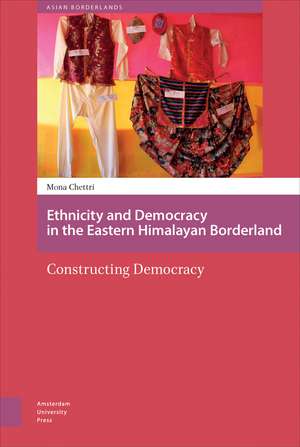Ethnicity and Democracy in the Eastern Himalayan Borderland: Constructing Democracy: Asian Borderlands
Autor Mona Chettrien Limba Engleză Hardback – 2017
This book presents a close look at the growth, success, and proliferation of ethnic politics on the peripheries of modern South Asia, built around a case study of the Nepal ethnic group that lives in the borderlands of Sikkim, Darjeeling, and east Nepal. Grounded in historical and ethnographic research, it critically examines the relationship between culture and politics in a geographical space that is home to a diverse range of ethnic identities, showing how new modes of political representation, cultural activism, and everyday politics have emerged from the region.
Preț: 500.49 lei
Preț vechi: 763.67 lei
-34% Nou
Puncte Express: 751
Preț estimativ în valută:
95.77€ • 102.41$ • 79.85£
95.77€ • 102.41$ • 79.85£
Carte indisponibilă temporar
Doresc să fiu notificat când acest titlu va fi disponibil:
Se trimite...
Preluare comenzi: 021 569.72.76
Specificații
ISBN-13: 9789089648860
ISBN-10: 9089648860
Pagini: 184
Ilustrații: 6 color plates, 4 halftones, 6 line drawings
Dimensiuni: 152 x 235 x 18 mm
Greutate: 0.45 kg
Editura: Amsterdam University Press
Colecția Amsterdam University Press
Seria Asian Borderlands
ISBN-10: 9089648860
Pagini: 184
Ilustrații: 6 color plates, 4 halftones, 6 line drawings
Dimensiuni: 152 x 235 x 18 mm
Greutate: 0.45 kg
Editura: Amsterdam University Press
Colecția Amsterdam University Press
Seria Asian Borderlands
Notă biografică
Mona Chettri is an independent researcher.
Cuprins
List of Acronyms
Acknowledgements
Introduction
Why Study the Eastern Himalayan Borderland?
Studying the Eastern Himalayan Borderland: Same Same but Different
Facilitating Ethnic Politics in the Eastern Himalaya
Organisation of this Book
1 Locating the ‘Nepali’ in the Eastern Himalayan Borderland
Becoming Nepali: Colonial History and Ethnic Group Formation
Going to Muglan: Emigration from the Kingdom of Gorkha to India
Language and Ethnic Group Formation
Homogenisation of the Nepalis and its Impact on Identity Formation
Gorkhaland: A Homeland for the Indian-Nepalis
De-Constructing the Nepali in Sikkim
Re-claiming Limbuwan
Conclusion
2 The Ethnic Worldview: Framing Existential Grievances
Limbus of Eastern Nepal and the Politics of ‘jati and nose’
Discriminating against the Sons of the Soil – the Gorkhas of Darjeeling
Fostering the Culture of Dependency in Sikkim
Conclusion
3 Ethnic Identity as Political Identity
The Political Resilience of the Brave Gorkha
Neither Mongol nor Kirat: Asserting the Limbu Identity
Claiming exclusive identities in Sikkim
Conclusion
4 Manifestations of Ethnic Politics
The Dress Code: Looking like a Gorkha
Becoming a Tribe in Sikkim
Limbus as the Embodiment of the Indigenous Discourse
Conclusion
5 Constructing Democracy
Emergence of a New Patronage Structure
The New Elites
Political Elites
Expressing Agency through Ethnic Politics
Regional Interpretation of Democracy
Conclusion
Conclusion
Being Nepali Across Borders
Of Ethnic Politics and Democratic Cultures
Ethnic Politics as People’s Politics
Bibliography
Index











